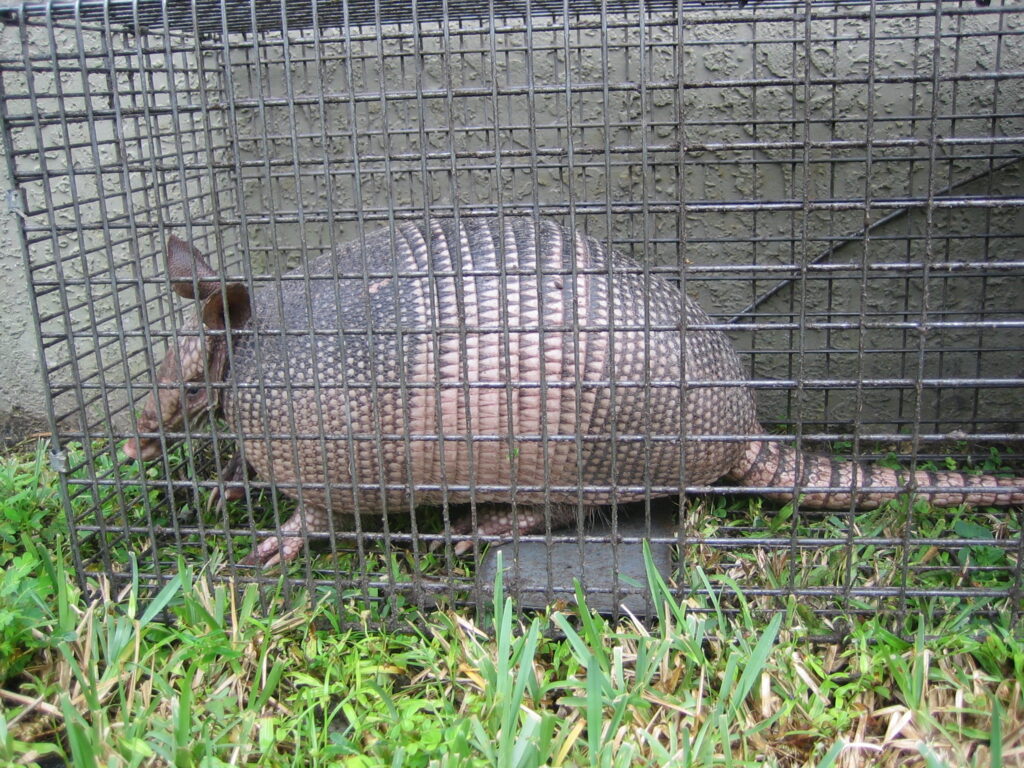Armadillo Removal and Armadillo Trapping is the best method of removing these nuisance pests from your property. Trapping is the fastest, most effective method of preventing an armadillo from destroying your lawn. It is often a tricky process because they are not attracted to food on the ground or a baited trap. These animals will not freely go into a cage trap in search of food. Armadillos primarily dig for their food, hence why they will not enter a baited cage trap freely. This is why trapping an armadillo should be handled by a professional Wildlife Control professional of Nuisance Wildlife Rangers. We are experts at Armadillo Trapping and have successfully provided these services throughout South Florida, Tampa, Fort Myers and Orlando areas.
We understand the complexities of dealing with these animals and can provide you with the best solutions.
The first armadillo removal method that we recommend goes right to the source. We’re talking about removing the things that are actually attracting the animal to your property in the first place. It’s generally easy and cheap to do, but it’s not always a foolproof solution.
In general, armadillos love to eat bugs, grubs, and worms as well as small plants. These are all things that are found in the ground. For this reason, it’s impossible to completely remove all an armadillo’s food sources from your yard. We also don’t recommend purging your yard of every single insect – this can cause other unforeseen problems.
What we do recommend is simply cleaning up your property. It pays to rake up any fallen leaves, berries, or other tasty plant parts. Additionally, removing brush and woodpiles can also effectively deter an armadillo. These animals like to make their burrows in areas with lots of cover. Clearing your yard as much as possible will make it less attractive to armadillos.


Bees can be some of the trickiest pests to hit up your property, not to mention one of the hardest to kick out. While you may purchase various deterrents or live traps for more common wildlife intruders, like raccoons, bees can be rather tricky. So what can you do if you’ve got an invasive bee colony on your property?
Unfortunately for us all, the honeybee population across the world is slowly diminishing. And while that may not seem like big news to you, it is, because honey bees play a crucial role in the pollination process, aka they make crops grow. They’re actually so important that farmers will even rent a honeybee swarm to pollinate their crops, or produce honey.
Bees are one type of pest that you should not attempt to remove yourself, unless you’re unable to contact a professional in due time. Obviously, if you suffer from even mild allergic reactions to bees, then you should avoid all contact, and leave it to a professional.
If you’re intent on attempting to remove the bees yourself, there’s a number of natural solutions you might opt for. Rather than physically removing the bees yourself, you’re trying to ward them off here gently. By no means should you try to approach or handle the beehive yourself, with or without protection.
Our professional beekeepers are really the only ones with the necessary experience and skill to remove the beehive without hurting the bees themselves. They are also able to remove the hive while maintaining the female bees calm and pacified. If a female bee becomes agitated, the situation can rapidly become dangerous, and even life-threatening. That’s why it’s important to keep her cool.
If at all possible, opt for the removal services of a beekeeper, or failing that, a nuisance wildlife removal company that uses humane methods (and doesn’t hurt the bees).
Not before they do significant damage. Once bees live in a wall or in an attic they will usually stay. The bees will make a honeycomb in the wall and up in the attic. Honeycombs will not go away on their own. Once the bees are removed, the honeycomb needs to be removed as well.
A honey bee hive will make a honeycomb fairly quickly. The rate at which the honeycomb is made depends on the size of the bee hive and if they are European honey bees or Africanized honey bees. Africanized honey bees were genetically created for their fast production of honey.
Whoever coined the phrase “where there’s smoke, there’s fire” must’ve been a bee, because that’s how the insects usually think. Since bees are highly sensitive to smell, you can easily repel them with smoke, because the smell of that will make them think they are in imminent danger, and flee the premises.
If bees fled your property after being exposed to smoke, they are unlikely to return, since they associate your property with danger.
Careful though, if you’re thinking of using a grill or another form of open fire to create smoke, and plan on being out in the open, do make sure you cover your body.
Another useful, and humane option of deterring bees is using natural strong scents to your advantage. Once again, bees are sensitive to strong smells, so things like garlic, cinnamon and citronella tend to put them off a property pretty quickly. You can either use scented candles, or even plant some of these nearby to convince bees to leave.
Warning: While you may find a lot of websites recommending the use of vinegar to ward off bees, the vinegar mix recommended is likely to kill the bees. So if you’re interested in live removal, we recommend staying away from that.
Nuisance Wildlife Rangers
2115 Lake Worth Rd.
Lake Worth, FL 33461
(877) 741-7703
© 2024 Nuisance Wildlife Rangers.
